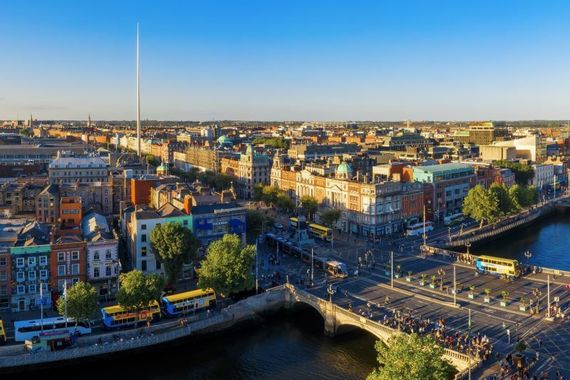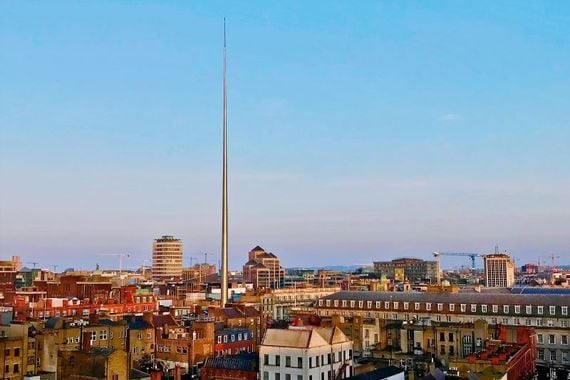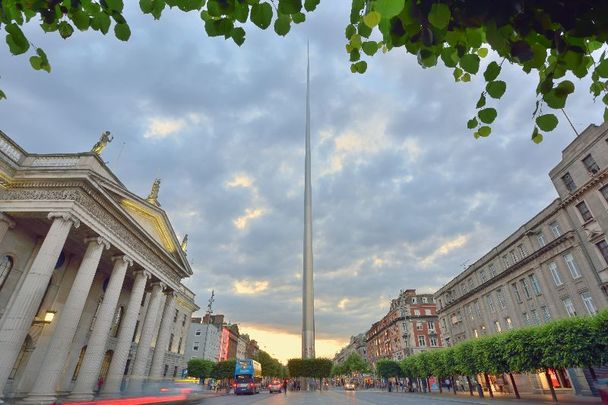The Spire, located in the median of Dublin's O'Connell Street between North Earl Street and Henry Street, turns 20 years old today, January 21, 2023.
The Spire, the 120 m high cone that is three metres wide at the base and tapers to 150 mm at the top, has become a fixture in Dublin City's skyline.
In 1998, Dublin City Council launched an international architectural competition for a monument to replace Nelson’s Pillar, which had been destroyed in a bombing in 1966.
The design for The Spire, submitted by the London-based Ian Ritchie Architects with an estimate of IRL £3 million, was selected from 205 entries by Dublin City Council in March 1999.

The Spire in Dublin. (Getty Images)
According to PublicArt.ie, a detailed Environmental Impact Statement was compiled by McHugh Consultants and submitted for certification in June 2000 to Noel Dempsey, then Ireland's Minister for the Environment. A planning inspector, Eoghan Brangan, was appointed to deal with the case and the public was asked for its views.
Of the 121 submissions received from the public, three-quarters were against the project.
Brangan noted that a quarter of the submissions were supportive - mainly from local businesses and commercial organizations, including the Dublin City Centre Business Association, the Dublin Chamber of Commerce, and the Irish Hotels Federation.
The Arts Council also argued in favor of the Ian Ritchie design, saying the monument's 'sheer vertical form' was an appropriate response to the 'broad horizontal nature' of O'Connell Street. With its 'unique and exciting design,' it would be 'a courageous embodiment of the 21st century and a monument worthy of a capital city.'
The Ian Ritchie design got the go-ahead, and the contract for this manufacturing work was awarded to SIAC-Radley JV and was manufactured by Radley Engineering of Dungarvan, Co Waterford, and erected by SIAC Construction Ltd.
The first section of The Spire was installed on December 18, 2002. Five additional 20m sections were added with the last one installed on January 21, 2003.

The Spire in Dublin. (Getty Images)
"The Spire was inspired by the ever-changing light and composition of the Irish skies," Ritchie Studio says, noting that "the tapering monument rises above O’Connell Street, breaking the roof line with as slender and elegant a movement as is technically possible.
“During the day its shot-peened surfaces softly reflect the sky and it sways gently in response to the wind.
“From dusk, the base is gently lit and the tip illuminated to provide a beacon in the night sky over Dublin."
Ritchie Studio says: "The mirror polished pattern on the lowest 10 metres around the Spire’s base was derived from studies of the rock strata beneath the site, overlaid with the double helix of DNA.
"The Spire slips through a cast-bronze disc flush with the surrounding paving without touching it, allowing the public to stand close and touch the Spire’s surface.
"The disc incorporates a logarithmic, varying depth spiral profile that follows the original theme of a spire: the past expanding through time into the future.
"As the base acquires a patina from the Irish climate and the golden polish of human contact, the historical role of bronze in the development of Irish art is carried into the future."
The Spire was completed in 2003 "in celebration of Ireland’s confident future in the third millennium," Ritchie Studio says.
Of course, being in Dublin, The Spire is not safe from colorful nicknames conjured up by locals, with some notable ones including The Spike, The Stiletto in the Ghetto, The Nail in the Pale, and The Pin in the Bin.




Comments